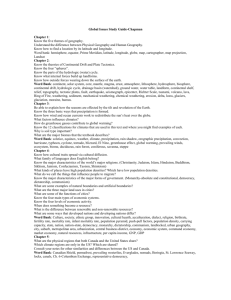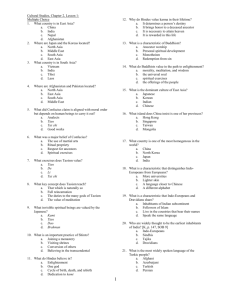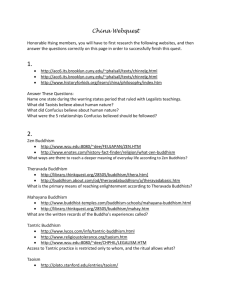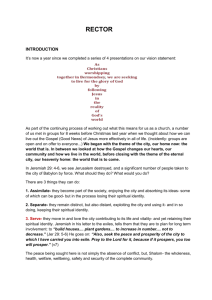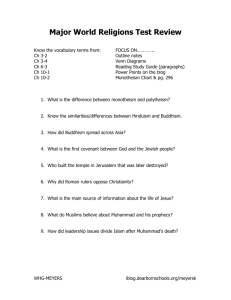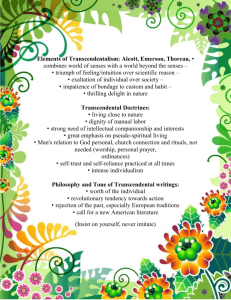Full Text
advertisement
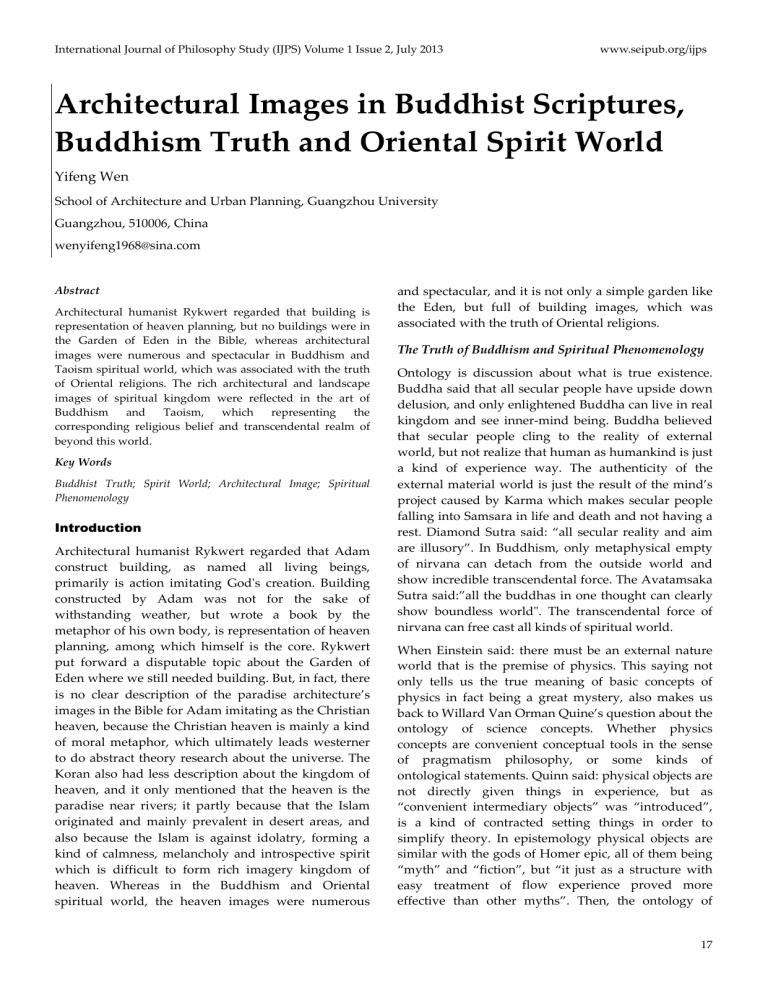
International Journal of Philosophy Study (IJPS) Volume 1 Issue 2, July 2013 www.seipub.org/ijps Architectural Images in Buddhist Scriptures, Buddhism Truth and Oriental Spirit World Yifeng Wen School of Architecture and Urban Planning, Guangzhou University Guangzhou, 510006, China wenyifeng1968@sina.com Abstract Architectural humanist Rykwert regarded that building is representation of heaven planning, but no buildings were in the Garden of Eden in the Bible, whereas architectural images were numerous and spectacular in Buddhism and Taoism spiritual world, which was associated with the truth of Oriental religions. The rich architectural and landscape images of spiritual kingdom were reflected in the art of Buddhism and Taoism, which representing the corresponding religious belief and transcendental realm of beyond this world. Key Words Buddhist Truth; Spirit World; Architectural Image; Spiritual Phenomenology Introduction Architectural humanist Rykwert regarded that Adam construct building, as named all living beings, primarily is action imitating Godʹs creation. Building constructed by Adam was not for the sake of withstanding weather, but wrote a book by the metaphor of his own body, is representation of heaven planning, among which himself is the core. Rykwert put forward a disputable topic about the Garden of Eden where we still needed building. But, in fact, there is no clear description of the paradise architecture’s images in the Bible for Adam imitating as the Christian heaven, because the Christian heaven is mainly a kind of moral metaphor, which ultimately leads westerner to do abstract theory research about the universe. The Koran also had less description about the kingdom of heaven, and it only mentioned that the heaven is the paradise near rivers; it partly because that the Islam originated and mainly prevalent in desert areas, and also because the Islam is against idolatry, forming a kind of calmness, melancholy and introspective spirit which is difficult to form rich imagery kingdom of heaven. Whereas in the Buddhism and Oriental spiritual world, the heaven images were numerous and spectacular, and it is not only a simple garden like the Eden, but full of building images, which was associated with the truth of Oriental religions. The Truth of Buddhism and Spiritual Phenomenology Ontology is discussion about what is true existence. Buddha said that all secular people have upside down delusion, and only enlightened Buddha can live in real kingdom and see inner‐mind being. Buddha believed that secular people cling to the reality of external world, but not realize that human as humankind is just a kind of experience way. The authenticity of the external material world is just the result of the mind’s project caused by Karma which makes secular people falling into Samsara in life and death and not having a rest. Diamond Sutra said: “all secular reality and aim are illusory”. In Buddhism, only metaphysical empty of nirvana can detach from the outside world and show incredible transcendental force. The Avatamsaka Sutra said:”all the buddhas in one thought can clearly show boundless worldʺ. The transcendental force of nirvana can free cast all kinds of spiritual world. When Einstein said: there must be an external nature world that is the premise of physics. This saying not only tells us the true meaning of basic concepts of physics in fact being a great mystery, also makes us back to Willard Van Orman Quine’s question about the ontology of science concepts. Whether physics concepts are convenient conceptual tools in the sense of pragmatism philosophy, or some kinds of ontological statements. Quinn said: physical objects are not directly given things in experience, but as “convenient intermediary objects” was “introduced”, is a kind of contracted setting things in order to simplify theory. In epistemology physical objects are similar with the gods of Homer epic, all of them being “myth” and “fiction”, but “it just as a structure with easy treatment of flow experience proved more effective than other myths”. Then, the ontology of 17 www.seipub.org/ijps International Journal of Philosophy Study (IJPS) Volume 1 Issue 2, July 2013 science can refer to what meaning? began to wake up in great wisdom. In this spiritual and state, the heart is not checked by material, but can “physics”, Quinn confirmed his phenomenological transform material phenomena. According to this truth, tendency. He said: in a variety of concept structure “it we began to read the ultimate meaning of spiritual has that one namely called phenomenology requiring kingdom images of Buddhism and the sacred land epistemological priority”. As phenomenon is the object projected by heart in religious paintings or arts. of direct experience and directly existence, and not The being set up or introduced and more fundamental. Amitayurdhyana Sutra is that: ʺto watch this Buddha, While to you must image on soil with seven jewels whereon phenomenology approach no more but into another lotus blossom with beautiful color and eighty‐four dead end. In 1953 in On Psychological Thing he flatly thousand veins, as same as heaven picture; the veins declared that “the concept of pure feeling materials is had eighty‐four thousand lights, all be seen clearly. an extremely empty abstract” and confirmed that “the Every leaf decorated by billions of Mani bead covering paradigm of nominalism is “extremely difficult”. This everywhere, and every Mani beads put forward difficult show in his disagree with Carnap who in thousands of bright light as canopy decorated with “Logic Structure of World” try to reduced all seven jewels.... in the platform, naturally had Dhvaja statements about world to that of direct experience, i.e. with four pillar as billions of Sumeru Mountain, all this from the basic conceptual relations of original like Suyama Palace with precious curtain.ʺ The images experience to define all other concepts, so putting showed in Dunhuang murals reflected the various whole world into ʺrational reconstructionʺ. In “On Buddhism sacred land of heaven like this, as shown in What Things Exist” Quinn said: “to translate all Fig.1. The Avatamsaka Sutra said: “while light go statements about physical objects through no matter through millions of world, over eastern billions of how complex and circuitous way into language of world, as same as southern, western and northern, as phenomenology is still actually impossible.” well as four dimensions up and down, every worlds Between paradigm Quinn of went “phenomenology” further according If this difficult should be resolved in scientific philosophy itself, it involves a critique of the concept of ʺobjectivityʺ. Even only from the view of tool rational, how the physical concepts and their objective can be understood, yet must be resorted to apriorism, i.e. prior ideas given by God, that is the basic spirit of Western religion. Whereas in Oriental religions, description of Sukhavati (Pure Land) in had billions Jambu Dvipa as well as billions of Akanis!t!ha, all contents of them are clearly showing”. That takes a more abstract, metaphysical way for description. Compared to the Husserl’s phenomenology which had too many problems to deal with, the above Buddhist scriptures is a kind of absolute spiritual phenomenology. especially in Buddhism, the “objectivity” be thought as being constructed. For example, in Buddhism’s view, everybody see it is raining, but there is not a “rain” ontological being, and “rain” is just produced by “similar” karma of the most people. The word “similar” is important and must be paid attention. It is just “similar”, and there is no objective thing with absolute identity for everyone. Buddhism believes that when we see the material world as the ultimate reality, we make a mistake, as same mistake as in dreaming someone who think that he saw his head being FIG.1 BUDHISM IMAGES SHOWED IN DUNHUAN FRESCOES The Ideal of Taoism and Related Art Images chopped off; if someone understands what he is Compared with Buddhism, Taoism heaven world pay actually in the dream when he is awake, the man more attention to beautiful scenes in this world for 18 International Journal of Philosophy Study (IJPS) Volume 1 Issue 2, July 2013 www.seipub.org/ijps imitation, such as the fairyland with three mountains ideal is also, of course, the theme of Chinese scholar in the East China Sea that like a dreamland of mirage paintings want to show, as seen in Fig. 2, while the and a phantasm of remote islands,which become an Yongle Palace’s mural directly gives the depiction of archetype for classical Chinese garden. Taoismʹs ideal various fairylands. is becoming an immortal being able to harness the genuine energy and fly freely in various wonderlands. “Xiao Yao” as keyword in Zhuang‐zi, which means transcendental “easy” and “free”, is particular philosophical language of Zhuang‐zi, to refer to a kind of spiritual transcendental freedom beyond here and now. “Forget time” and “detach everything” is regarded as real approach from vulgarity to fairyland. In development of Taoism, in addition to imagine out abstract spiritual worlds including the highest “Three Pures” realm, the more colorful fairy worlds reflected in poetries, paintings and legendary stories. Especially scholar’s landscape paintings clearly reflect this feeling of passion for beautiful scenery. In Ming dynasty myth novel “Journey to the West” gave very clear depiction about fairyland worlds: “mist and clouds in the twilight, the moon and sun showing move, there is FIG. 2 CHINESE SCHOLAR’S LANDSCAPE PAINTINGS Yongle Palace’s mural which located at Shanxi Province in China is a flower of Chinese ancient mural paintings; its artistic value is comparable to that of Dunhuang frescoes. It is not only an important thousands of old cypress and bamboo grove......, masterpiece in Chinese paintings, also is rare project in outside flowers like brocades, precious grasses are the world painting history. The whole mural has a fragrant beside bridges, green embellish around total of 1000 square meters, respectively drawing on abrupt cliffs, suspended rock with moss growing, the wall of several buildings of the temple, as shown in frequently hearing the cry of cranes, often seeing the Fig. 3‐5. Among them, the Three Pures hall is a main fly of phoenixes....., black apes and white deer are building which had a mural called “pilgrimage to the hidden and appearing sometimes, golden lions and Origin God”, as shown in Fig. 3. The picture being 4.26 jade‐like elephants being freely action and rest, looking meters high, 94.68 meters length, a total of 403.34 thoroughly at Elysian Fields, it is just a wonderful square meters, depicts Taoist Ordination Ranks which heaven.” This was the scenery firstly looked by was completed in due form in early Tang dynasty . Monkey King just arriving at Lingtai Mountain and Sanxing Cavity, then he went to the Heaven Palace and saw that: ʺbefore the building for pilgrimage, crimson gauze clothing like the stars shining, lotus crown is splendid and magnificent, all immortal with jade hairpin, beaded shoe, purple ribbon and gold award......, the Heaven Palace had jade gate with gold nail and surrounded by winding corridors, wherein colorful phoenixes and dragons flying, everywhere were exquisitely carvedʺ. Lingtai Mountain and Sanxing Cavity is a metaphor for ʺheartʺ in Chinese character; the fairyland is just the produce of Taoism’s “heart” with transcendental spiritual freedom. This FIG.3 PILGRIMAGE TO THE ORIGIN GOD 19 www.seipub.org/ijps International Journal of Philosophy Study (IJPS) Volume 1 Issue 2, July 2013 Jiangxi, Zhongtiao Mountains in Shanxi and so on for secret cultivating Taoism,and no one knowing his eventual situation. The conclusions There are two kinds of existence for man, namely, the being of reality and transcendent; in other words, human exist in the two realms: this world and beyond FIG.4 IMMORTAL world, and “light” is the interface of the two worlds. The material world is that one under light, while beyond light is that of transcendent. Aristotle divided two worlds as intro‐lunar and ultra‐lunar by moon, but the light is a true thing that can separate two worlds. Einstein said it is impossible to travel faster than light, only because the light makes everything hard for practical experience. In this sense, it is not impossible to travel faster than light, but once we go FIG.5 ENLIGHTENINGLUDONGBIN In the sector wall of Chunyang hall there is a mural called “Zhonglihan enlighten Ludongbin” which depicts Ludongbin and Zhonglihan sitting on a mountain rock; the background is a vigorous pine, flowing springs around. Zhonglihan who sit front the pine, a twinkle in his eyes, with a kind and friendly smile on his face,wearing hempen shoes with barefoot, topless and easy posture, just watch Ludongbin. Ludongbin sit and listen with humbly demeanor; the details of his hands catching sleeve, the left hand gently twisting the right sleeve, have exposed the inner contradiction of uncertainty about what he is going to do, as shown in Fig.5. The story depicted by the beyond the speed of light, which means that we enter a realm with infinite dimension for spirit. The truth of Buddhism and ideal of Taoism is to enlighten human to give up and from clinging to the external world of ordinary experience, turning to pursuit the inner transcendental existence. The transcendental empty of nirvana is inconceivable infinite, even the Buddha refused to make any concrete answer for what about it. Why the Buddha said human have an upside‐down illusion, also because the transcendental nirvana as well as its corresponding truth which is vastly different with so‐called everyday common knowledge. REFERENCES painting speciously reflects the world view and ideal Taoism. The hero Ludongbin was born at YongLe Rykwert. “On Adam’s House in Paradise: The Idea of the town in Ruicheng city in Tang dynasty (799 AD). Primitive Hut in Architectural History.” New York: Ludongbin’s family background was official, at youth Museum Art, 1972. he was keen on imperial examinations and official Wang Chengwen. ”On the formation of Deity System of rank, but until 64 years old he just acquired a Three Pures in the medieval Taoism: An Invesitigation of successful imperial the Dunhuang Manusicript Lingbao Perfect Text of examinations. In legend, Ludongbin was pleased to Original Endeavor of Universal Salvation.” Journal of Sun travel, and encounter the Taoism master Zhonglihan; Yat‐Sen University (social science edition) 2(2008):34‐59. candidate in the highest by Zhonglihan’s enlightenment he hence gave up human wealth, learning and practicing immortality, and he successively traveled to Lushan Mountains in 20 Willard Van Orman Quine. ”From a Logical Point of View.” Harvard University Press, 1980. Yifeng Wen. “The Fundamental Conception and Theory of International Journal of Philosophy Study (IJPS) Volume 1 Issue 2, July 2013 www.seipub.org/ijps Natural Philosophy: A Mega‐theory of Green Building Zhao Dehong. “What is the Real Meaning of Xiao Yao in and Eco‐homeland.” Applied Mechanics and Materials Zhuang‐zi.” Journal of Ancient Books Collation and 71‐78(2011): 4701‐4709. Studies 5 (2012):87‐90. 21
